We’re dropped by a van a few blocks from our main point of interest today. We walk past houses, swept clean each morning and decorated with rice powder designs that will be eaten by ants by the end of the day.
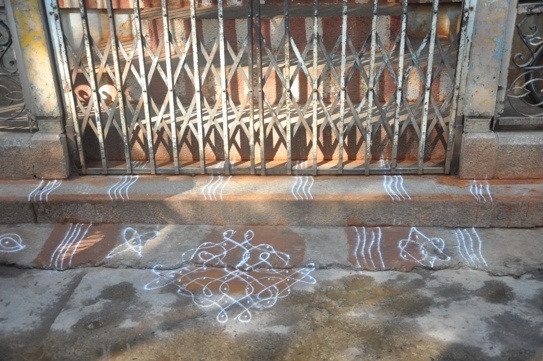
As we walk, Jay tells us the legend surrounding the origins of Madurai, which involves a story about a couple who has a young girl with three breasts. They are upset about the fact that she’s a girl, and about her deformity. Oh, hell, i can’t remember all the twists and turns, but she kills a demon, marries Shiva, gets back down to two breasts and turns out to be a beautiful fish-eyed goddess (apparently, women with fish eyes are real knock outs), one of the incarnation of Parvathi. As the story goes, Shiva then looks down and drops of nectar fall from his locks, resulting in the city being named Madurai or “The City of Nectar”. So, have you got it?
Ancient Madurai was a center of Tamil culture, famous for its writers and poets, and the history goes back to the 6th century BC when it traded with Greece and Rome. It’s one of the longest continually-occupied cities in the world. The Nayaka Kings laid out the old own in the pattern of a lotus with narrow streets surrounding the Minakshi Temple, which is a temple complex of thirteen buildings constructed over a period of several centuries. Minakshi is the “fish eyed goddess” who is also the consort of Shiva. Shiva has a temple dedicated to him in the complex. Since Minakshi is the presiding goddess, the daily ceremonies are first performed at her shrine and then at the shrine of Shiva. This is a living temple and each shrine has priests performing rituals in front of them, and it’s really the varied life around the temple that is interesting. I’ll try to convey some sense of it through a bunch of photos.
First, there are the impressive towers of the temple
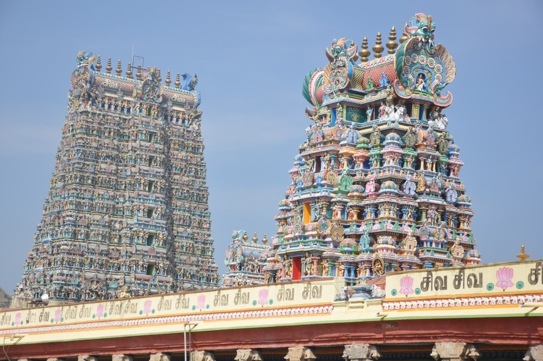
We see a group of men moving a heavy sedan platform on which a statue of Parvathi will be carried around.
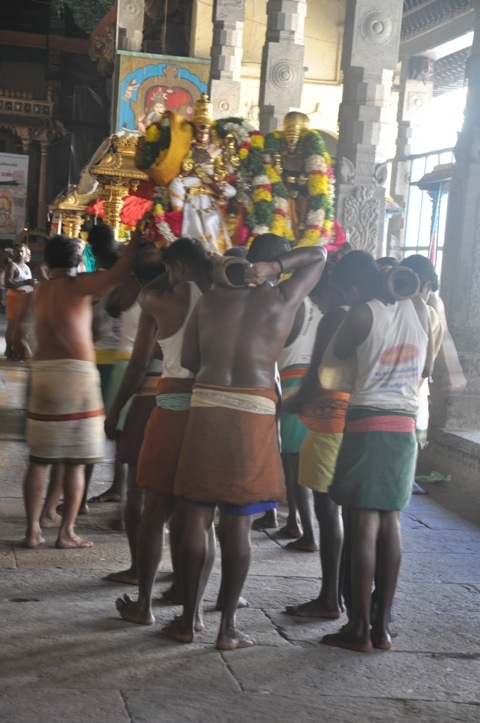
There are myriad shops surrounding the temple complex, some selling offerings for pilgrims to bring to the gods. Housed in the remains of a 16th century ruin nestled amongst the decorated pillars and carvings are a remarkable collection of stalls selling everything from silk scarves to pink plastic (Carol bargains for four barrettes for the girls, getting four for $2.40, and causing the rest of us to wait ten minutes to talk the seller down from the outrageous $3 price he’d proposed.)
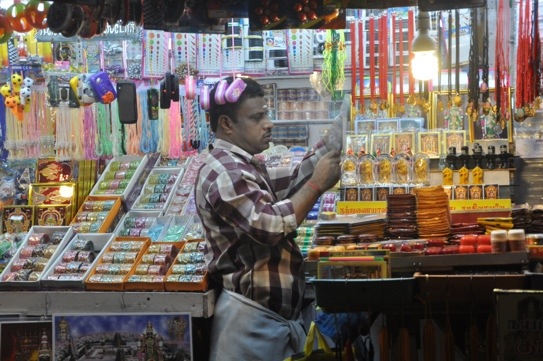
A group of men and women are clearing cement from an area in the center that will eventually be filled with water, passing heavy containers of cement from one to the next.
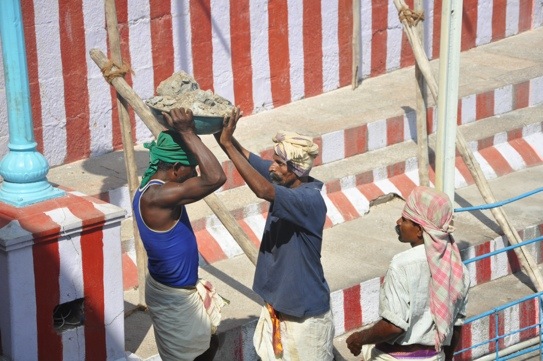

People pray.
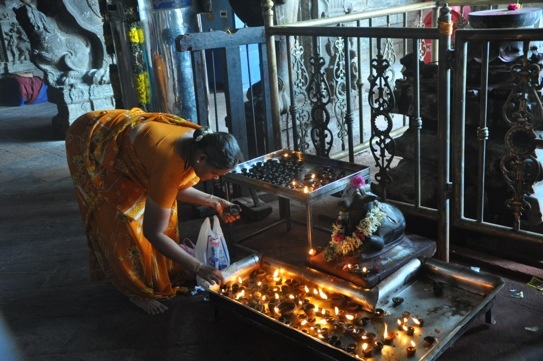
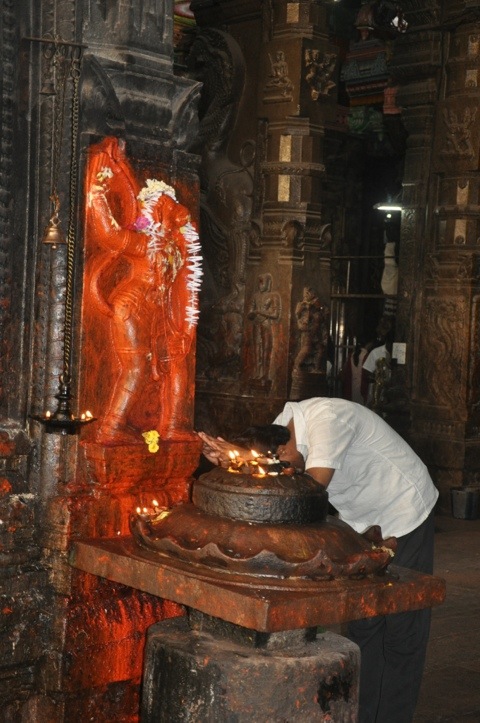
Priests sit at the shrines, or have tea together after prayers.
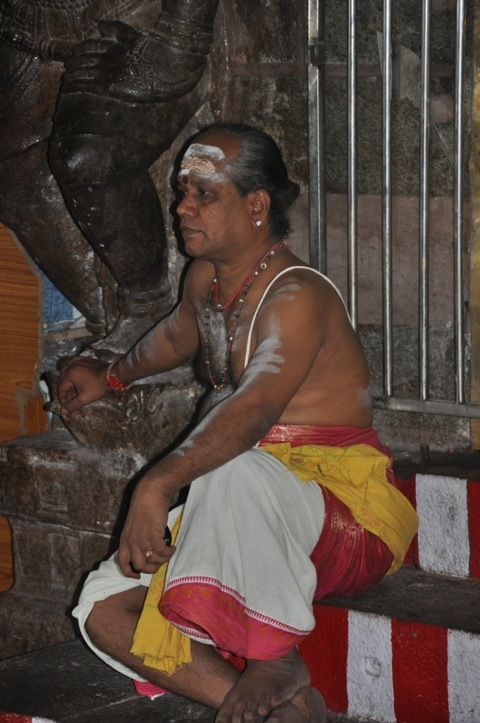
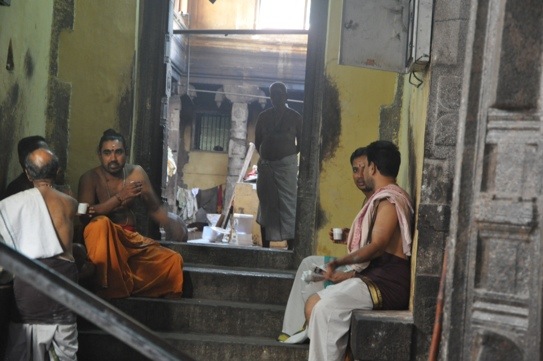
Children join their parents and adoring grandparents, some of them brought to be blessed by the gods.
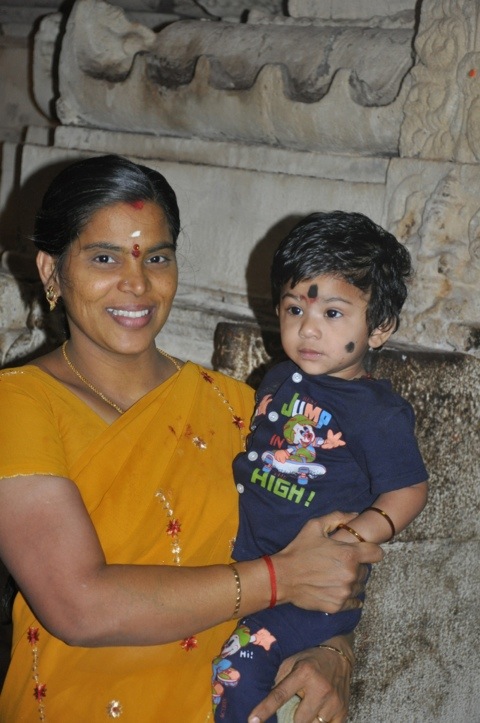
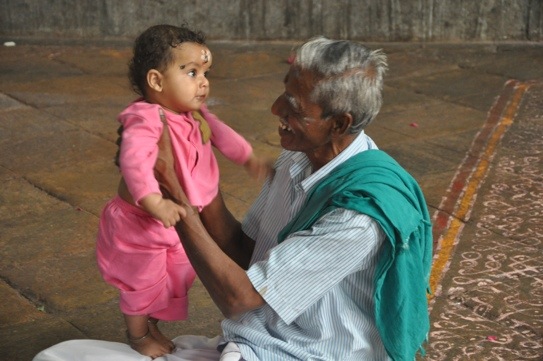
A newly-wed bride is fitted with toe rings.
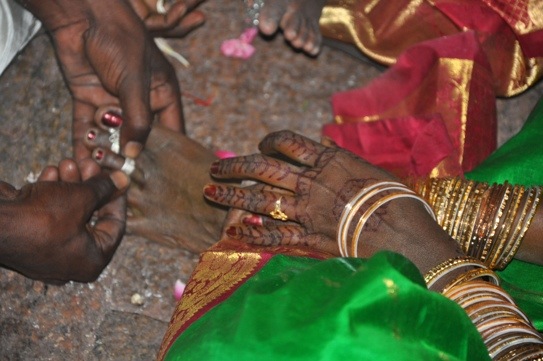
Shrines are decorated with flowers.
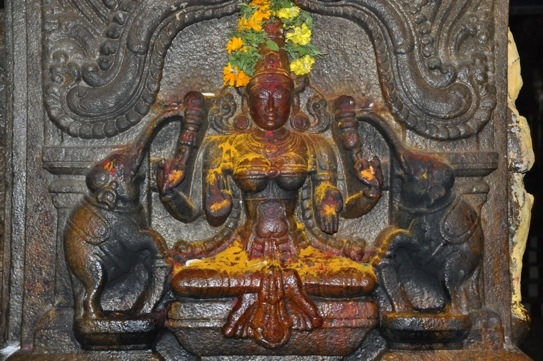
We explore the markets surrounding the temple, passing streets selling an extraordinary variety of items. But there is order in the chaos. The area is a like a huge open air department store, each street dedicated to one particular item – stationery, flowers and fruits, vessels, items used in worship etc. There is even one lane dedicated to bananas – South India boasts over 50 varieties. We are joined by locals, shopping in typically colorful dress.
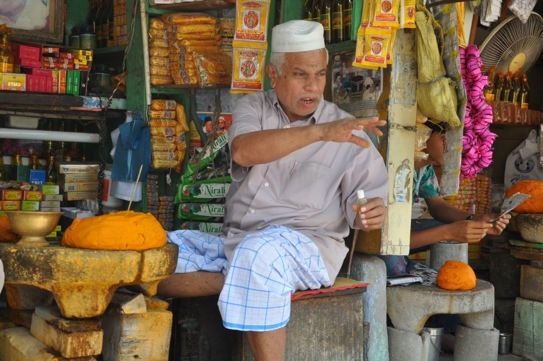
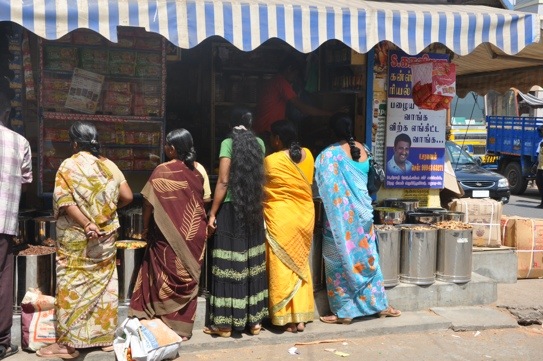
The highlight of the walk is a stop at a tea shop, where we have delicious “meter” coffees, mixed by the proprietor by pouring them from a height of a meter. Starbucks is due to come to India soon, and we’re guessing that the coffee, which we paid fourteen cents a cup for, will probably go for about $3.50.
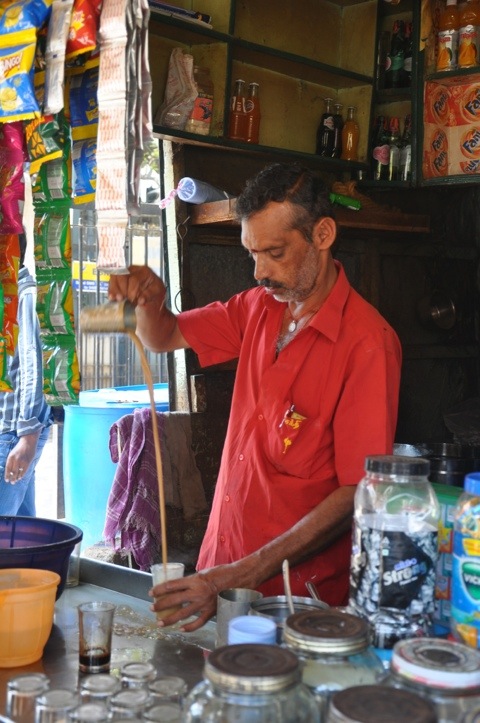
We drive a short distance and stop for an excellent lunch at a small hotel restaurant, the return to our hotel for rest, relaxation, blogging, etc., before the evening activities.
Picked up at 6:00, we head for a movie theater. Since we’ve heard so much about the movie-craziness of Tamilnadu, we decide to give it a try, and, as we’re our own bosses, there’s no problem in doing that. Jay has gone ahead to purchase tickets in the VIP area (cost $1.20), which is air conditioned. The movie is Slave Girl, made in 1968, starring MGR, former leader of Tamil, and co-starring the current leader as his leading lady.
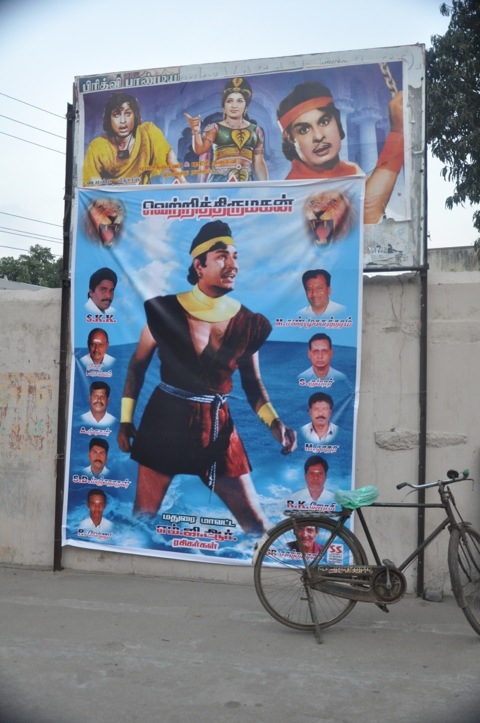
The film (and it IS a film, complete with a projector that stops at random times, is a VERY corny, dated story of good versus evil, with lots of sword fights, rescues, flashbacks and singing. We make it until intermission, about an hour and a half.
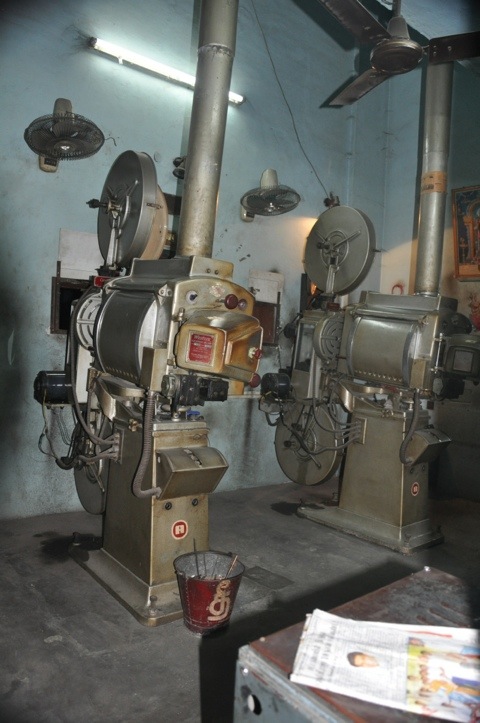
We head for a hotel for a snack/dinner, which does the trick, and then head to the Minakshi temple for the nightly symbolic putting to bed of Shiva and “Fisheyes”. This involves a procession, with priests carrying an ark-like, small silver house with a black stone (Shiva linga) representing Shiva inside. There is music, fire, prayers, waving of fans, blowing of conch and sprinkling of water. The concept is not unlike the putting to sleep of Mother Ganges each night that we witnessed in Varanasi on our first trip to India, and it’s well worth seeing. hosting information . We go barefoot, as we have in all living Hindu temples that we’ve entered.
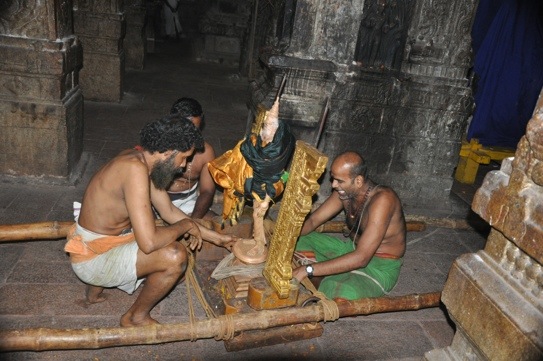
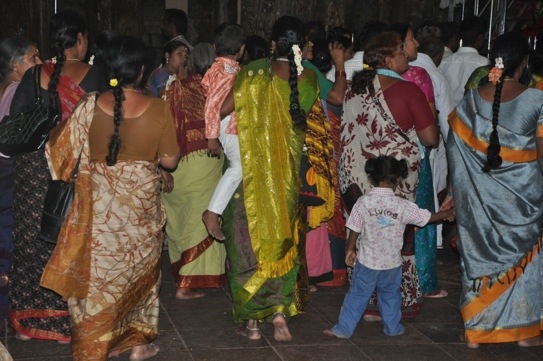
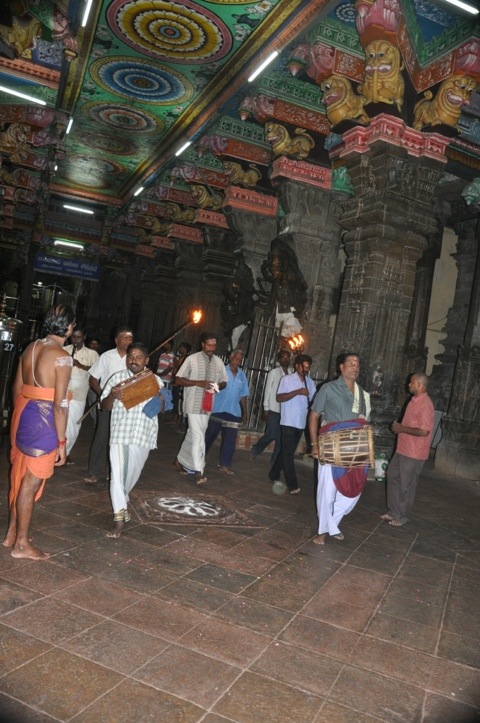
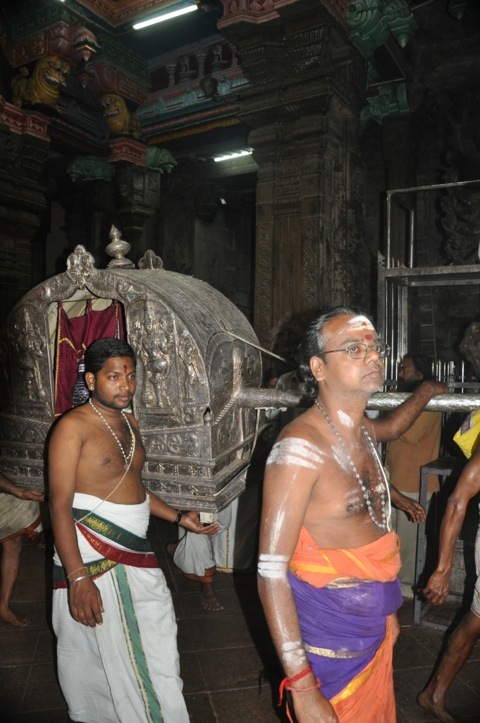
Driving home at 10:30, Madurai is still very-much open for business (though not as bustling as it was on our way to the temple at 8:45), as Jay says it will remain well into the wee hours of the morning, unlike any other Indian city. We return to the hotel and forego a drink in favor of retiring.
Today is a slower-paced schedule, which is a welcome change. And we don’t have to go into any damn Hindu temples. I’m kidding, of course, as the temples have been great. But a day off from Lord Shiva feels welcome to this Jewish guy.
We have stayed at some terrific hotels, and this one, set in a magnificent old mansion, is elegant and distinctive, with rooms on two floors around an open atrium.
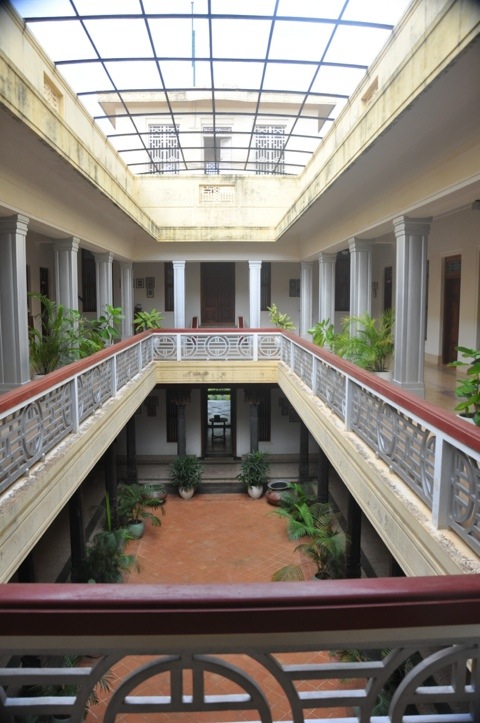
We travel around Chettinad by ox-drawn cart, a leisurely and great way to do it (except when you come face to face with oncoming motorized traffic). It’s a sign of the times that towards the end of our ride the old ox-cart driver receives a call on his cell phone.
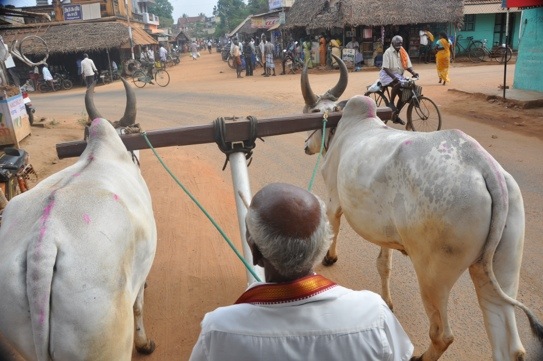
The Chettinad region at one time represented the wealth of Tamil Nadu. The many villages were once the homes of fabulously wealthy merchant families known as the Chettiars. Today it is an area of mostly deserted magnificent mansions. Just one of the Chettiar houses used 300 tons of satinwood and Burma teak in its construction. One of the specialties of these houses is the woodcarving especially on the doors.
We stopped to visit one of the run-down, occupied mansions and saw the inside and some of its inhabitants.
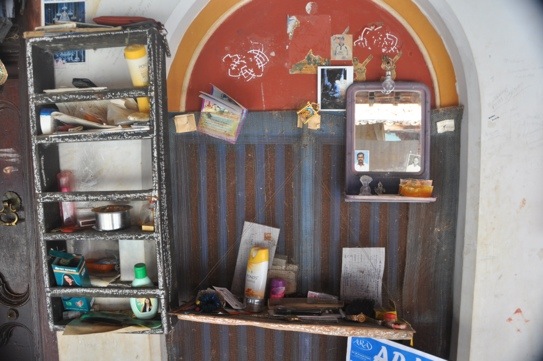
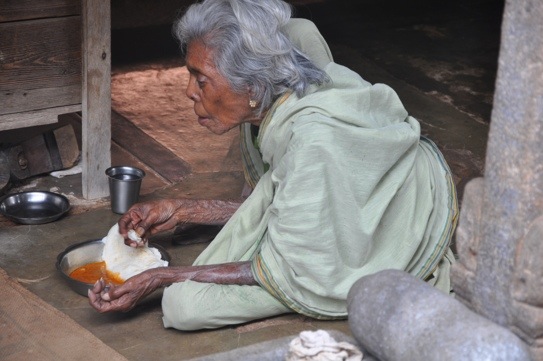
With recent interest by tourists, some of the old mansions are being bought and refurbished, used either as hotels or homes. As they now stand, real estate parlance would call them “handy man specials.”
We forsook our oxen for the minibus, and drove to a place where beautiful tiles are being made out of cement. We saw the whole process, which involves putting a piece of glass into a metal frame, pouring paint on the glass, using forms to create a design, sprinkling on dry cement, pouring wet cement into the frame and smoothing it out, drying it for a day, submerging it in water for two days to strengthen the cement and, finally, allowing it all to dry for five days and removing the glass. We’ve seen demonstrations of many crafts and arts around the world, but this one was a first for two reasons: we actually understood it and nobody tried to sell us anything afterwards. The end product is quite wonderful.
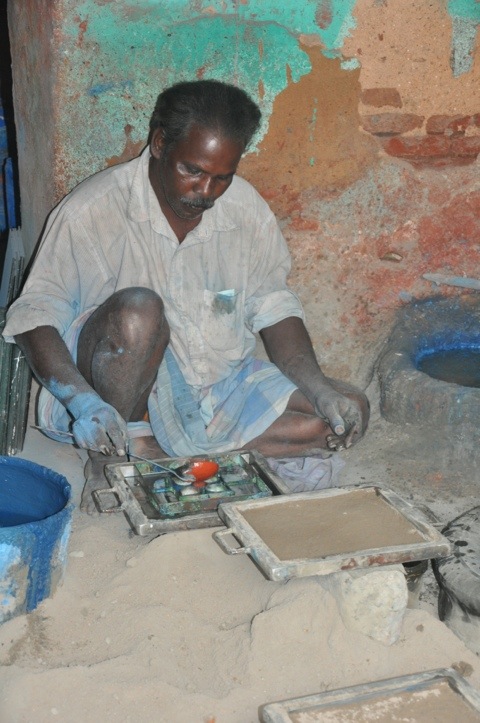
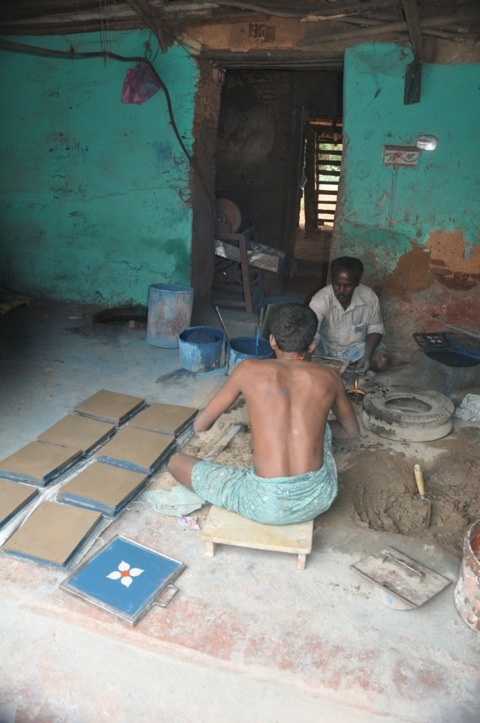
After the demonstration, we walked around a nearby vegetable market.
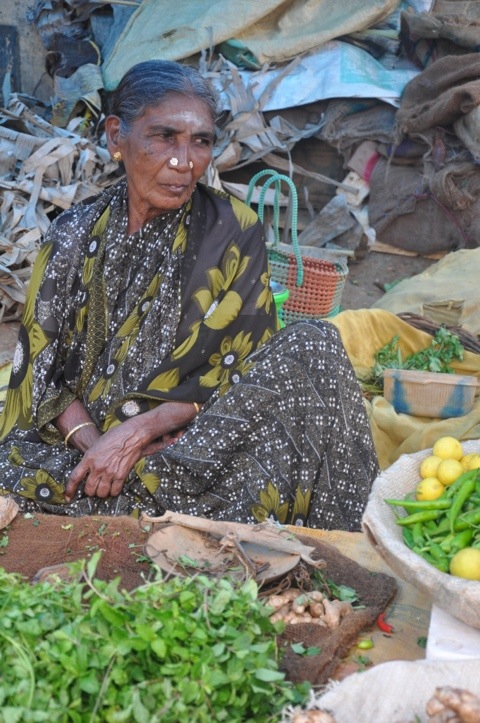
From there, we drove to another hotel, housed in a large mansion, for an excellent traditional South Indian Tali lunch, composed of many different dishes spread on a banana leaf and eaten with your hands. The owner of the home chatted amiably with us. This hotel was also lovely, but not quite as nice as the one we stayed in.
We set out for Madurai, stopping at a town to walk through an antique market, where Karen and Steve bought a brass knocker for their front door. Along the road today we have seen large numbers of pilgrims who are walking to a temple some 200 kilometers away. The walk will take them five days, and they will make an offering when they arrive. web api security . Jay tells us that a very large pilgrimage in Kerala, an area we will visit later, attracted 20,000,000 people over a month and a half period, and raised over 180,000,000 rupees in contributions.
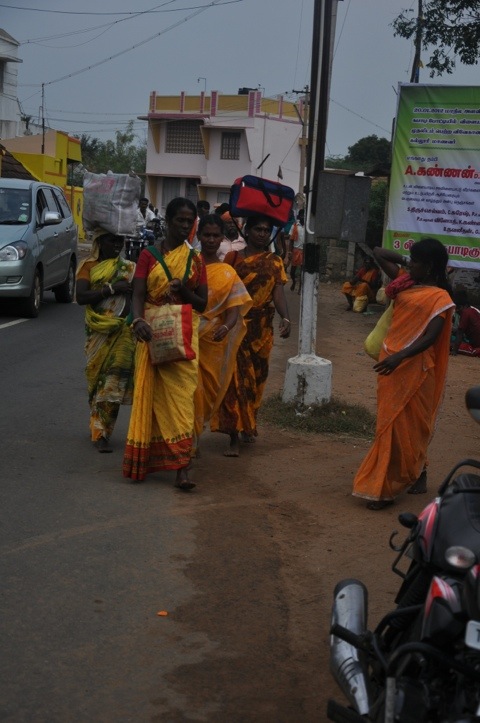
We drive on through Madurai, the second largest Tamil city at 1.4 million people, and on to The Gateway Hotel, situated on a mountain top, high above Madurai. We have a lovely view, with a large terrace that overlooks the city.
We relax in room, then walk up to the restaurant for a pretty good dinner with pretty lousy service.
After breakfast, we’re shuttled from our hotel to our minibus for an 8:30 start. As usual, there’s a lot to see and talk about, goats being herded, flightless ducks eating the remnants of rice stalks, which they’ll help to fertilize with their droppings, Jay brings topics alive by using articles from today’s newspaper. Local boys have been injured in bull turning, grasping bulls by the horns and turning them, a rather dangerous sport. Supplementing his discussion yesterday of free color TVs for poor people, Jay points to a photo of a leader from a nearby state presenting a free mixer/blender to a poor person in fulfillment of a campaign promise. He also shows us an article about a chair in Indian studies having been created at the University of Chicago in the name of a Hindu Indian Swami who had lectured there 150 years ago, and been one of India’s first cultural ambassadors.
Jay also elaborated on the obsession of Tamil people (not all Indians) with movies. Poor people will sell blood to get money to buy movie tickets, every house has pictures of movie stars, MGR, leader of Tamil, and a huge movie star had the largest ever funeral, more people attended than for Ghandi, lines formed for miles to donate kidney to him, and their were many suicides on his death. His successor in office is one of his former first ladies in films. People will do anything to see a movie, Getting in line at 6AM to get a ticket for a 10 PM show. Movies are the number one source of entertainment, feeding the dreams everyone at lower levels has for happy lives.
We drive on to Thanjavur, the capitol of the Great Chola Empire, which ruled from the tenth through the twelfth centuries, and extended over all of South India, and as far as Sri Lanka and even Bali. The Chola kings who were great patrons of the arts built most of the 93 temples at Thanjavur, of which the Brihadisvara Temple is the showpiece. While they lavished their wealth on the temples, they also encouraged the belief in the divine right of kings, and the practice of donating a part of one’s wealth to the temple for spiritual gain.
The Brihadisvara Temple, also known as the “Big Temple”, was built between 985 and 1012 AD and is a World Heritage monument. It is a magnificent structure with a 14- story high vimana, a towered sanctuary that houses the main deity. Built mainly of granite, the temple has superb inscriptions and sculptures of Shiva, his consort Durga and Vishnu.
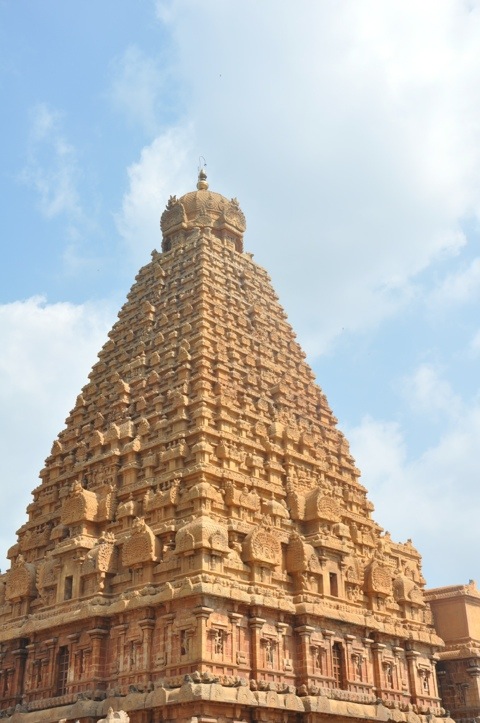
After leaving Birhadisvara, we drive to a former palace that now houses an excellent museum which has an exceptional collection of bronzes, many of them of a dancing Lord Shiva, surrounded by a ring of fire.
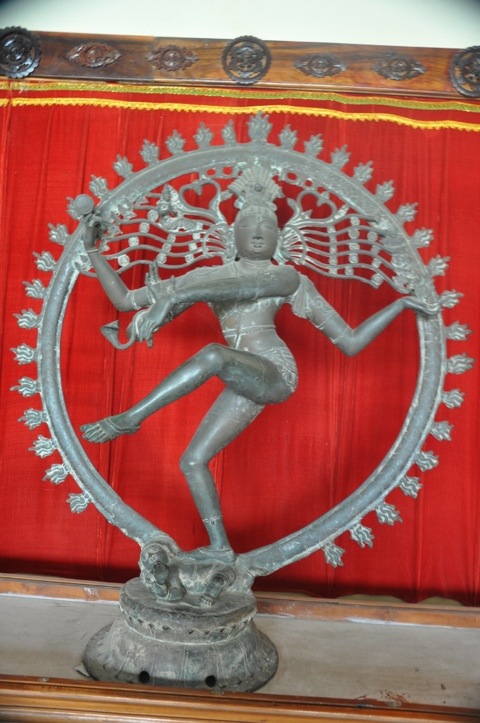
After a very good lunch at a nearby hotel restaurant, we drive approximately three hours to Kanadukathan in the Chettinad region, stopping at an Ayyanar temple located in a forest. This temple is a mix of craft, myths and rituals and have local deities which are considered to be village guardians. In Hinduism, symbolism plays an important role, and to ensure that the deity can reach them speedily in times of need, devotees bring terra cotta horses as offerings. expired domain names Walking up the forest path to the shrine, we pass thousands of these horses, produced over hundreds of years for an annual festival, many of which are in an advanced state of disrepair. Behind the main shrine is the poignant sight of hundreds of terra cotta dolls, brought as offerings by women who are unable to have children.
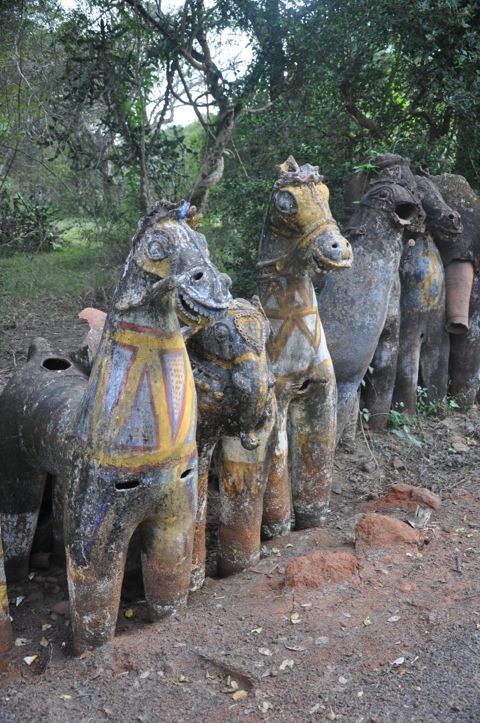
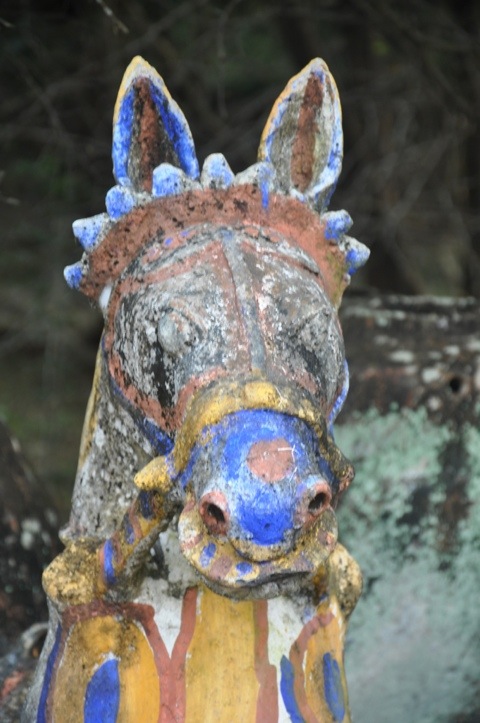
We arrive at Hotel Visalam, a marvelous old Chettiar mansion that has been refurbished and retains much of its original teak woodwork from Myanmar as well as its former furnishings. The Chettiars were highly successful business men who achieved wealth through money lending. We’re given a tour of the beautiful house and grounds, then shown to our large, high-ceiling, marble-floored suite.
After a swim in the large pool, which is large enough for me to do laps, we clean up, and blog. Carol and I meet Jay in the lobby. At our request, he’s brought a map of South India and shows us the route we’ve taken thus far and identifies for us the territories ruled by various rulers over the centuries.
We meet Steve and Karen for dinner on the second floor balcony on yet another perfect evening of weather, then retire.
After breakfast at the hotel, we set out for the capital of the Chola Empire, Chidambaram, one of Tamil Nadu’s most important holy towns. We are traveling comfortably in a minibus, which has a capacity of ten. With Ravi, our driver, and Jay, our guide, we are only six. Ravi has done an excellent job of driving. He’s friendly, but doesn’t say much. I’m gaining confidence that we’ll probably survive the constant threat of oncoming traffic on our side of the road, though I have asked Jay for the Hindu word for death.
We pass a wedding hall, and Jay asks if we’d like to go in. Of course, we would. Outside the hall is a big poster with pictures of the bride and groom, as well as smaller pictures, below them, of men who have contributed to the cost of the poster.
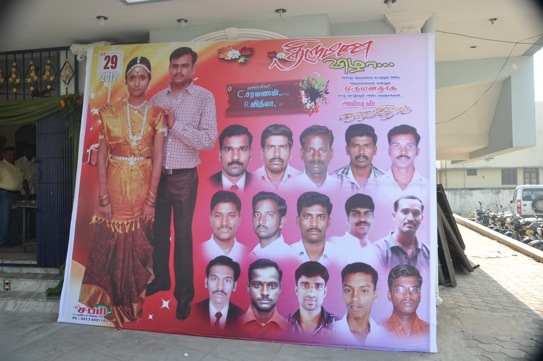
We’ve seen these posters elsewhere, and sometimes they contain a picture of a movie star, as well. (Tamil Nadu people are crazy for movies. Jay says that people will watch a movie fifteen or more times. We’ve seen people sitting parked in cars and vans, watching movies.)
We are welcomed into the wedding hall, where the wedding ceremony is just ending, and the bride and groom are receiving guests up on a stage. Gifts lay piled up on the floor beneath the stage to help the couple start their new lives together. Weddings are huge events in India, with families saving for twenty years to pay the cost. A modest wedding may have 1,000-1,500 guests. Everyone wears their finest dress–a new sari is a must–and gold and jewels abound. A photographer and videographer are recording the event on the stage, and Jay encourages me to go up to photograph with them. The crowd parts to allow me to do this.
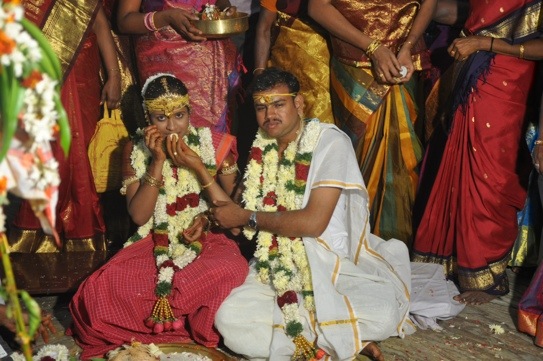
Guests at the wedding insist that Steve, Karen, Carol and I go up on the stage to greet the bride and groom, which we do. We’re invited to have breakfast several times, but Jay explains to disappointed would-be hosts that we’ve just eaten and must leave. Before we go, we pose for photographs with the bride and groom. On our way out, we’re given gift bags from the wedding, which include a cocoanut and other goodies. As we drive away from the wedding, we pass many guests, women with flowers in their hair, jewels and fine saris, riding on back of motor bikes. In the car, Jay tells us that DVDs will be made of the festivities and sent to wedding guests, and that we will be the stars of the DVD.
We leave Ponchiderry, which was granted independence from the French in 1956. Goa achieved its independence from Portugal even later, in 1963. Both are now separate union territories governed by India, but not states. They do elect representatives to the government.
Arriving in Chidambara, we head to the Nataraja Templ, which is dedicated to Shiva in his form as Lord of the Cosmic Dance. Shiva was the patron god of the Chola kings. The temple area covers sixty acres, dwarfing the temple we saw in Chennai.
Jay had told us that it was the goal of every dancer to dance at the temple of “The Dancing Shiva” and we witness several young girls fulfilling their dream. Because of the dance recital we attended in Chennai, we’re able to appreciate the dancing much more than we otherwise would have.
The temple is run by dikshithar priests who have beards and hair tied with a knot in back. They are Brahmins and wear a string around their body as a sign of their status. At this temple, any married dikshithar can serve as priest for any god, so they rotate around to different shrines, but serve the gods 24/7, 365 days a year. The temple is a hubbub of activity, people old and young, priests, families, beggars. Bells clang, and people crowd to see the priests inside the shrines waving oil lamps in circles.
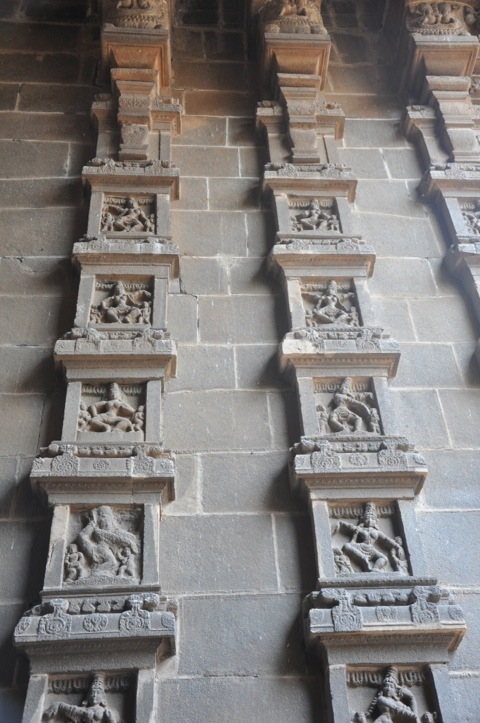
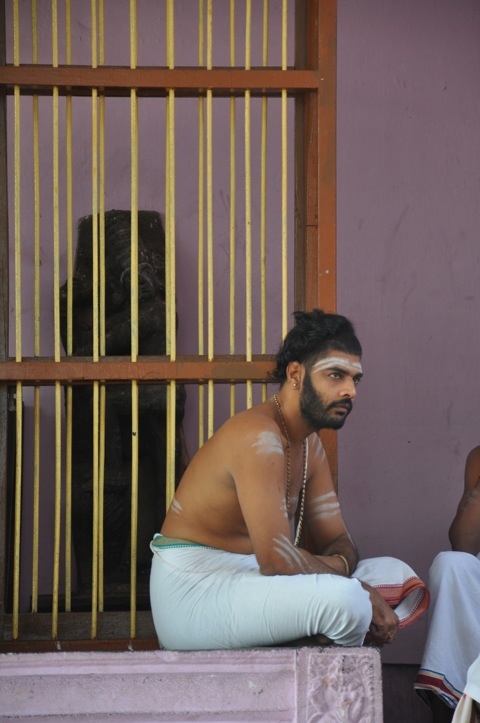
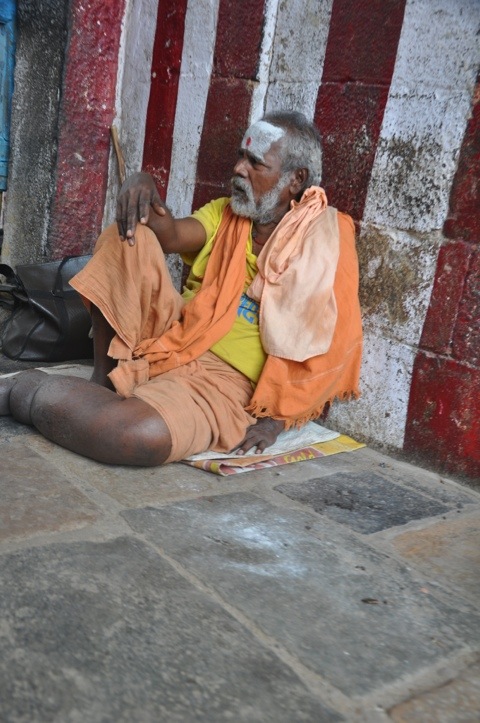
We leave the dancing Shiva and drive a short distance, stopping at a restaurant for lunch. Steve, Karen and Carol all have local, Tamil food on a metal tray, with rice, all of which they eat with their hands. I opt for Chinese–hot and sour soup and Chinese vegetables with rice, all of which is surprisingly good.
After lunch, we drive through the heart of Tamil Nadu, just missing buses, trucks and motor bikes, passing through small towns with markets, seeing damage from the recent cyclone, tractors loaded high with sugar cane, trucks stacked with hay, oxen ploughing rice fields, moving stores of materials carried on bicycles. We talk with Jay about everything from trees we see to snakes, rats and mongoose in rice fields to corruption in government and 20-year delays in court cases to the Tamil Nadu political party’s pledge to give poor families a color TV, if elected. This pledge has been honored, with millions of color TVs given to everyone with electricity. The populace favored this over the opposition party’s pledge of rice for one rupee (two cents) a kilo. Who needs rice when you can watch your favorite movies in color?
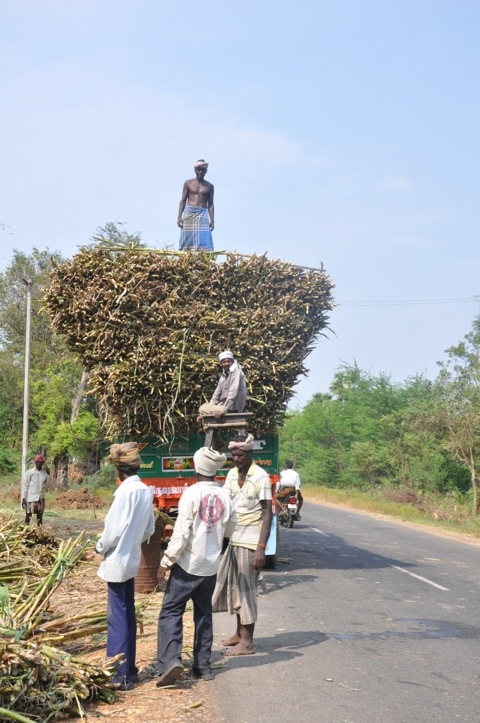
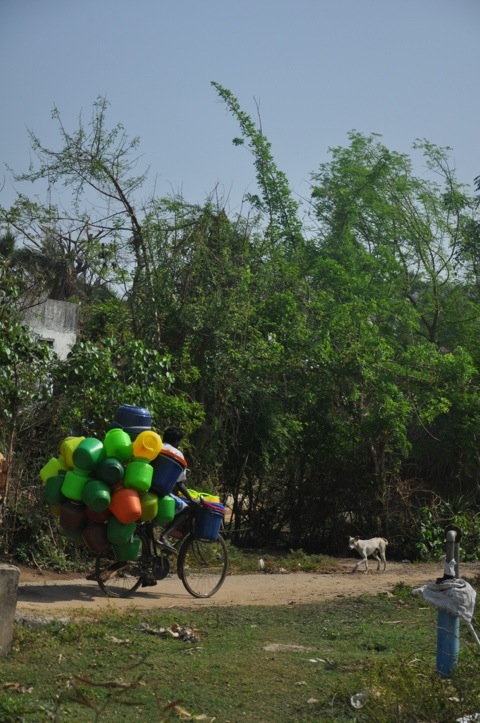
We stop at Darasuram to see the Airavatesvara Temple, the third of the great Chola temples after Thanjavur and Gangaikondacholapuram. Originally called the Rajarajesvaram temple when it was built in 1146, it was renamed Airavatesvara Temple after Indra’s white elephant, who followers of Shiva claim, worshipped Shiva at this temple. Built mainly of granite, the temple has pillars with beautifully carved Apsara and friezes of lively dancing figures and musicians. Each of the pillars within the temple illustrates mythological stories showing the penance of Parvati, Shiva’s consort. Though the temple was largely destroyed, it has been carefully reconstructed as an archeological site, not a living temple, allowing us to photograph shrines that we could not take pictures of in a temple that was being used. The temple is definitely worth seeing, but not nearly as interesting as living temples.
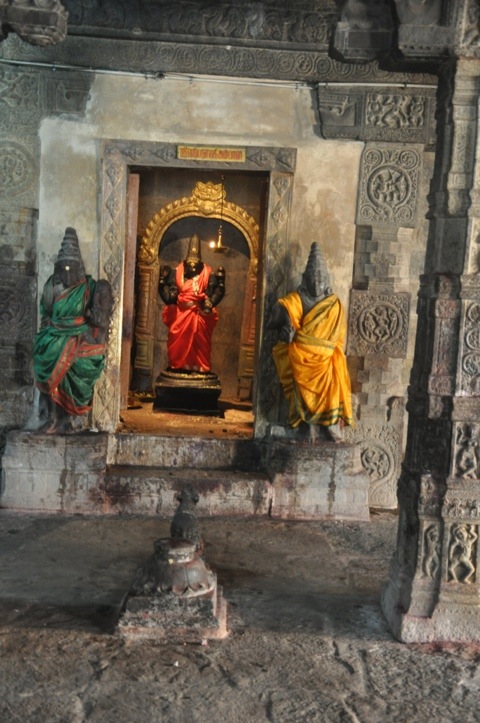
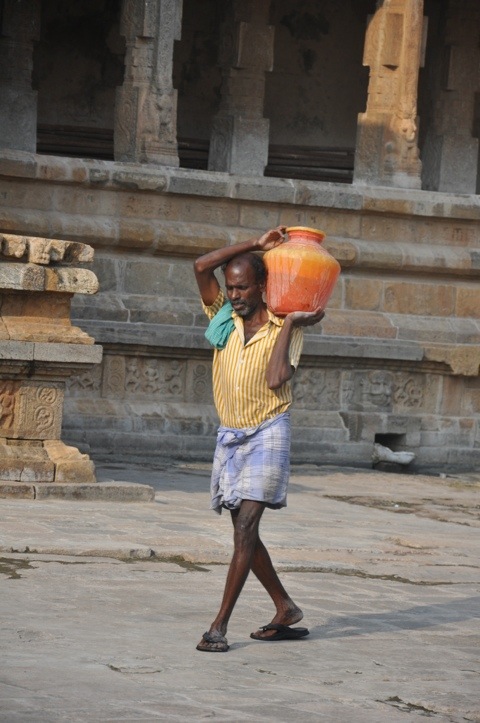
We continue on towards our hotel, Hotel Mantra Veppathur. Because the hotel cannot be reached in our vehicle, we stop by the side of the road and are ferried in on a large golf-cart type vehicle. We check into a very nice two bedroom villa with a large, tiled common area, which we share with Steve and Karen.
Steve and Karen scout out the pool and spa, making massage reservations for themselves at 6:30, and for Carol and me at 9:00. Steve, Karen and I have the large, lovely pool to ourselves. They go for massages, we hang out at he room, then go for a fair dinner at the hotel’s vegetarian restaurant, are joined at our table later by the Sugarmans, leave them for our (excellent) massages, then reconnect briefly in our villa, before retiring.
Breakfast at the hotel, and then on the road again, heading south for Pondicherry, which was ruled by the French until Indian independence. Along the way, we see a man on a moped, virtually hidden by the pots he is carrying for sale, and bullocks with colorful horns, painted for the harvest festival. We talk with Jay, peppering him with questions that occur to us from time to time to try to learn more about the history and culture of this region. As we enter Ponchiderry, we see policemen, still sporting bright red caps that were worn by the French.
Pondicherry is best known for Auroville, “The City of Dawn” which was established in 1968 to continue the teachings and beliefs of the Indian philosopher Sri Aurobindo who lived and worked here. Built as a utopian paradise by his disciple, Mirra Alfassa, also known as Mother, it was planned so that people could live and work here irrespective of religion, caste or nationality. More than 2000 people from some fifty countries occupy the area, the land donated and supervised by by India and the project recognized by UNESCO. We walk about a kilometer to the most striking feature, the Matrimandir, a large, golden sphere, composed of some 4000, gold-colored disks, which houses a white marble chamber (which we are not able to enter) that is a meditation center. Inside the chamber a crystal which reflects the sun’s rays serves as a focal point to aid meditation.
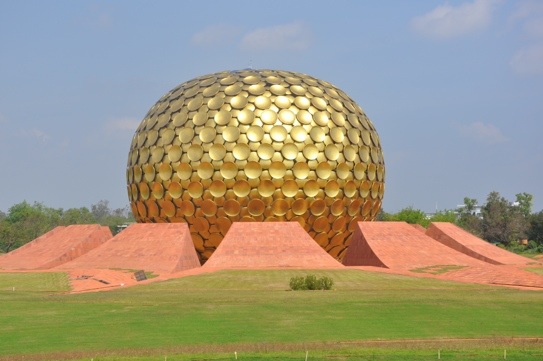
From Auroville, we drive to our hotel Le Dupliex, a charming French house that has been converted to a lovely hotel. Because Steve taught a student whose family owns the hotel, they are upgraded to a very large suite. Our room, though, is more than adequate. We lunch in the breezy, open courtyard of the hotel, then relax for awhile before setting out for a walk through the former French Quarter with its elegant colonial mansions, tree-lined boulevards, bars and cafes, which provide a sense of the history of the town.
We stop and give an elephant minder a few rupees, so that the elephant will bless Carol by touching her on the head with his trunk. We walk around and stop in a rather upscale shop in which we buy some very nice scarves.
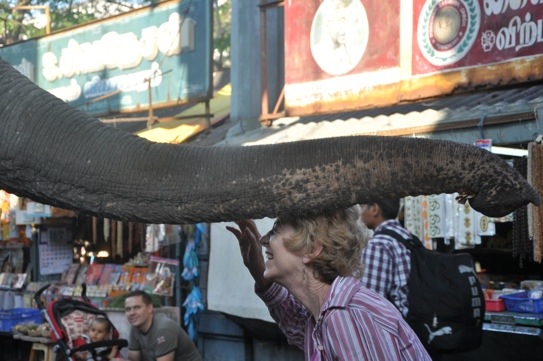
We stop at an ashram, the former home of Sri Aurobindo, whose philosophy inspired Auroville. We walk through, silently and without photographing, as required. People file by the tomb of the philosopher, some bowing or praying to give homage to him, touching their heads to the flower petals that form an intricate design on the tomb. Many people sit in the room, meditating. We continue walking, past the bed used by Mother and the chair in which Sri Aurobindo used to sit. It really is quite moving, perhaps more so than our visit to Auroville.
From the ashram, we walk by the sea. Large crowds of families stroll along the walk and beach, dressed in their fine clothing on this Saturday evening. We discuss differences with Jay in our cultures, how nobody would dress up in the US to walk by the beach, and how this serves as the major source of entertainment for Indians, other than going to movies. Eating out is not common as it is in the States, and, in fact, is thought by many to signal a problem in the family. Only the rich would think of going to the theater, or a concert or dance, except for periodic festivals at temple.
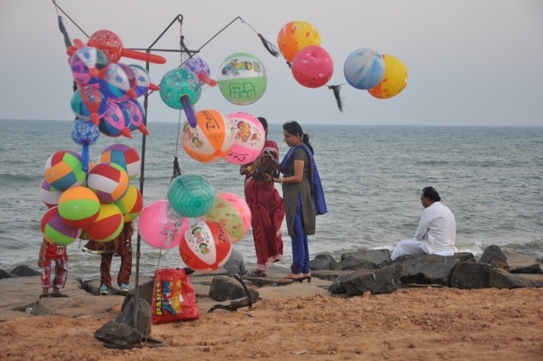
We return to the hotel, where Karen is waiting, having gone ahead in anticipation of receiving a call from a friend of a friend, who is a ceramicist living in Pondicherry. Karen tried, a number of times to reach her by email from the States and had tried to call before, all unsuccessfully. A last try this afternoon, managed to connect with Deborah Smith, who said she’d call later. Karen told us that Deborah was coming by in 15 minutes and wanted us to drive her by her house for a quick look.
Our experience with Deborah is a testament to the virtue of (Karen’s) persistence. A Stanford graduate, she studied pottery in Japan, before moving to join Sri Aurobindo. Her now husband, Ray Meeker, a talented ceramicist and architect, joined her in Pondicherry, where they’ve lived, worked and taught for more than forty years. Their house, in the French Quarter is absolutely stunning, modern, high ceilings, large rooms and an open atrium. The house would have been more than worth the visit, but the collection of pottery they had displayed, almost all of which was done by former students, some of whom are now nationally-known potters was just fantastic. Carol and I, and the Sugarmans, we’re blown away by it, and Deborah was most gracious in spending an hour or so showing and talking to us about the collection. This was a truly unexpected delight.
After, we had an excellent and very reasonably-priced dinner in a restaurant called Le Club, recommended by both Deborah and Fodor’s, half a block away from Deborah’s house, then walked the five blocks back to our hotel to retire.
|
|















































